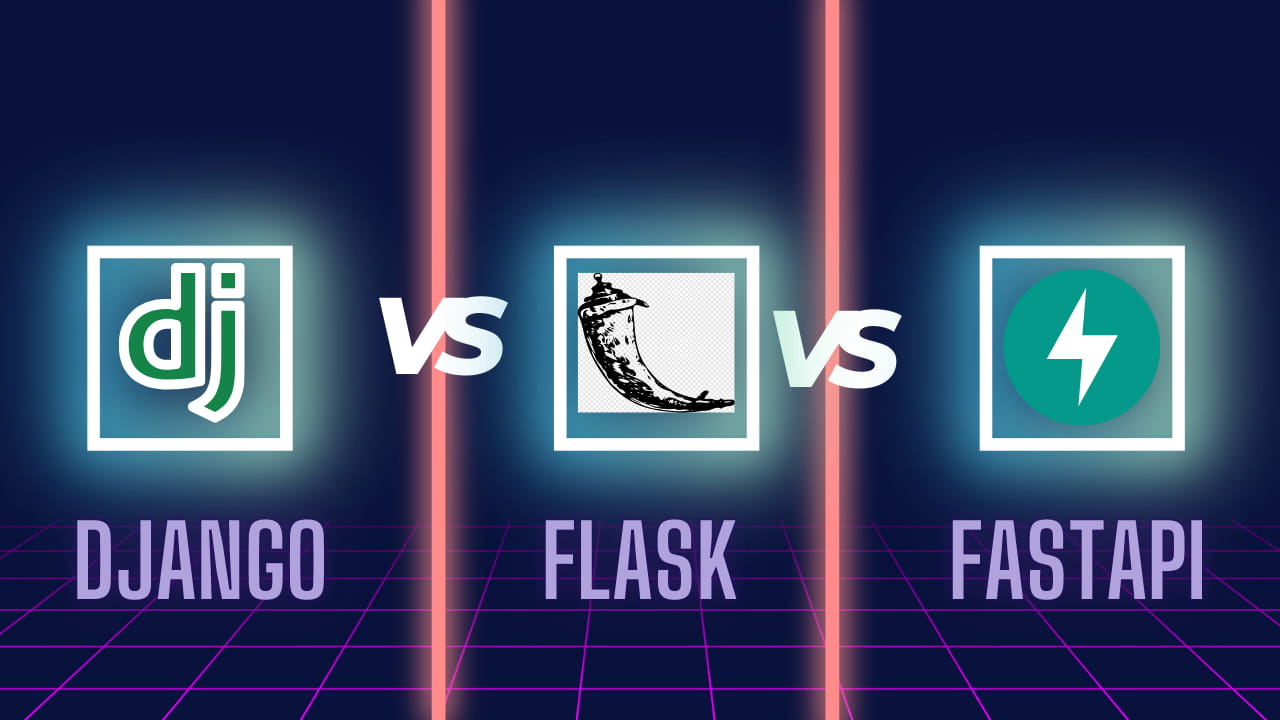When it comes to building web applications with Python, one of the first decisions you’ll face is: which web framework should I use? With popular options like Django, Flask, and FastAPI, making the right choice can feel overwhelming, especially if you're not sure how they differ or which one fits your project best.In this article, we'll explore what a web framework is, why it’s essential, and break down the strengths and weaknesses of Django, Flask, and FastAPI to help you confidently choose the right one for your needs.
What Is a Web Framework?
A web framework is a collection of tools and libraries that help developers build web applications more efficiently. Instead of writing everything from scratch—like routing, request handling, HTML rendering, database connections, and security—you can rely on a web framework to handle these core tasks. Frameworks provide a structured way to build applications, reduce boilerplate code, and enforce best practices. They speed up development, enhance maintainability, and make your codebase more scalable.
Why Use a Web Framework?
Using a web framework saves time, improves security, and helps you follow a consistent development pattern. Some key benefits include:
- Rapid development: Reuse of pre-built modules and components.
- Built-in features: Authentication, ORM, templating engines, and more.
- Security: Protection against common vulnerabilities like CSRF, XSS, and SQL injection.
- Community support: Established frameworks have large communities, extensive documentation, and plugins.
Now let’s dive into the three most popular Python web frameworks: Django, Flask, and FastAPI.
Django: The Full-Stack Powerhouse
Django is a high-level Python web framework designed to help developers build robust, scalable web applications quickly. Its famous motto, “The web framework for perfectionists with deadlines,” reflects its goal of making development both fast and clean. Django follows the Model-View-Template (MVT) architecture and includes built-in tools like an ORM, authentication system, and an auto-generated admin panel. These features make it ideal for developers who want a full suite of tools ready to use without spending time choosing and integrating third-party packages.
Django projects follow a structured pattern that enforces best practices, making collaboration and maintenance easier. It supports a variety of databases, has a rich plugin ecosystem, and includes middleware for handling sessions, messages, CSRF protection, and more. However, Django may feel too heavy-handed or opinionated for small projects. Developers looking for flexibility or minimalism may find the framework limiting due to its conventions and larger learning curve.
Pros:
- Admin Interface: Auto-generated admin dashboard for managing data.
- ORM (Object-Relational Mapper): Built-in support for defining database models in Python.
- Security: Automatically handles many security issues like CSRF, XSS, and SQL injection.
- Scalability: Used by large-scale sites like Instagram and Pinterest.
- Community & Documentation: One of the largest and most mature Python communities.
Cons:
- Less Flexibility: Its "Django way" can feel rigid for small or custom setups.
- Overhead: Might be overkill for small or API-only projects.
- Learning Curve: Takes longer to master due to its size and many conventions.
Ideal for:
- Complex, database-driven websites.
- Content management systems.
- Projects needing rapid prototyping with built-in admin tools.
Flask: The Lightweight Minimalist
Flask is a micro-framework that provides the essential components to get a web application running—like URL routing and request/response handling—but leaves the rest to the developer. This minimalist philosophy gives you complete control over how you structure your app, which tools you use, and how you handle things like databases, authentication, and templating. Flask doesn’t impose any specific project layout, making it a favorite for developers who want a lightweight, modular approach.
Because of its simplicity, Flask is extremely easy to get started with. It’s often chosen for small to medium projects, REST APIs, and prototypes. As your application grows, you can plug in extensions like Flask-SQLAlchemy (for ORM), Flask-Login (for user sessions), or Flask-RESTful (for APIs). However, this flexibility also means you’re responsible for architecture decisions and integrating packages—something that can be a challenge as your app becomes more complex.
Pros:
- Lightweight and Flexible: Add only what you need, when you need it.
- Simplicity: Easy to learn and get started with.
- Rich Ecosystem: Tons of extensions for things like authentication, ORM, etc.
- Great for Microservices: Perfect for building small and focused services.
Cons:
- No built-in ORM or Admin: You need to manually integrate tools like SQLAlchemy or Flask-Admin.
- Scalability Requires Planning: You’ll need to organize the app structure as it grows.
- More Decisions to Make: Freedom means more setup and choices for the developer.
Ideal for:
- Small to medium applications.
- Prototyping and lightweight REST APIs.
- Developers who want full control over architecture
FastAPI: The Modern Async API Builder
FastAPI is a modern, high-performance web framework built for developing APIs with asynchronous support, type validation, and automatic documentation. It leverages Python type hints to validate and serialize request/response data using the Pydantic library. FastAPI is built on Starlette (for the web parts) and Pydantic (for data validation), which makes it incredibly fast—comparable to Node.js and Go in many benchmarks. This performance and ease of use have quickly made it the go-to framework for building APIs, especially in the fields of data science, machine learning, and backend microservices.
One of FastAPI’s standout features is the automatic generation of OpenAPI documentation through Swagger UI and ReDoc, which requires almost no additional effort from developers. This makes API testing and client integration much easier. FastAPI is also async-ready by default, allowing developers to write non-blocking code using async/await for improved performance under high load. However, it is not a full-stack framework—you’ll need to add templating engines or ORMs separately if building anything beyond an API. Also, its reliance on type hints may intimidate those not familiar with Python's static typing or asynchronous programming concepts.
Pros:
- Async Support: Built-in async capabilities make it ideal for high-concurrency apps.
- Fast Development: Auto-validation of request and response data using Python type hints.
- Automatic Docs: Swagger and ReDoc generated out of the box.
- Performance: One of the fastest Python frameworks available.
- Great for Modern APIs: Especially with background tasks, websockets, etc.
Cons:
- Not Full-Stack: Lacks built-in templating, ORM, or admin.
- Smaller Community: Newer and less mature than Django or Flask.
- Learning Curve: Type annotations and async/await may confuse newcomers.
Ideal for:
- REST APIs and microservices.
- Projects that require async operations (e.g., real-time features).
- Machine learning model deployment and backend APIs.
Django vs Flask vs FastAPI – A Comparison
Each framework brings a unique approach to web development, and none of them is inherently better than the others. It all depends on your project’s scope, complexity, and requirements.
Django is your go-to choice when you want a complete solution with minimal decisions to make. It shines in large, database-driven applications where speed of development and admin tooling are crucial.
Flask gives you the flexibility to build your app your way. It’s great for developers who prefer to choose their tools and need more control over architecture. Flask works well for microservices or apps where performance and customization are priorities.
FastAPI is ideal when performance, modern features, and API-first development are key. If you’re building async applications or want robust validation and automatic docs out of the box, FastAPI is a strong contender.
How to Choose the Right Framework
Choosing the best Python web framework depends on your project’s complexity, performance needs, team experience, and long-term goals. Here's how you can decide:
New to Web Development?
Start with Django
If you're just beginning, Django provides a complete toolkit—ORM, admin panel, authentication system, templating engine, and more—all in one package. This means you don’t have to worry about wiring together multiple tools or making early architectural decisions. Its opinionated structure also teaches good development practices like code organization and reusable apps, making it a great learning platform.
Need a Small, Quick App or Simple REST API?
Use Flask
When time is short or the project is simple, Flask’s minimalist nature shines. You can build a working app or prototype in hours, not days. It's great for small businesses, MVPs, or internal tools. Because you control what to include, you only add what you need—keeping the project lightweight and fast to deploy.
Building High-Performance Async APIs?
Go with FastAPI
If your application requires handling thousands of concurrent requests—like chat apps, IoT platforms, or background-heavy tasks—FastAPI is designed for performance. It uses modern async features and type hints for fast execution and error checking. Plus, the built-in auto documentation helps teams and clients understand and test your APIs with ease.
Need a Built-in Admin Panel and Rapid Backend Dev?
Django is Unbeatable
Django’s auto-generated admin interface allows you to manage your data without writing a line of frontend code. For content-heavy apps like blogs, CMSs, or dashboards, this can save weeks of development time. It’s especially useful in startups or corporate environments where backend tools need to be spun up quickly.
Want Full Control Over App Structure and Tools?
Flask Gives You Freedom
If you're an experienced developer or working on a custom architecture (like microservices or API gateways), Flask’s flexibility allows you to design everything your way. You pick the database, authentication, serialization format—everything. It’s like having a blank canvas where you choose the tools best suited for the job.
Deploying a Machine Learning Model as an API?
FastAPI is Your Best Bet
FastAPI’s support for JSON serialization, async execution, and seamless data validation with Pydantic makes it ideal for exposing ML models as APIs. Data scientists love it because it feels like working in a typed, modern Pythonic environment. Plus, the built-in Swagger UI allows fast testing of model endpoints.
Choosing the right web framework is less about which one is the "best" and more about what fits your project, team, and goals. Django, Flask, and FastAPI are all excellent tools with different strengths. By understanding what each offers—and what your project truly needs—you’ll be equipped to build better, faster, and smarter.

